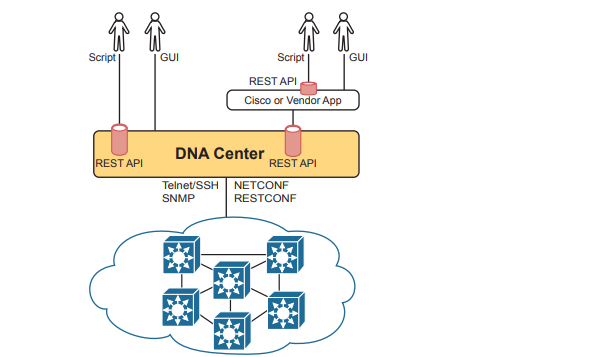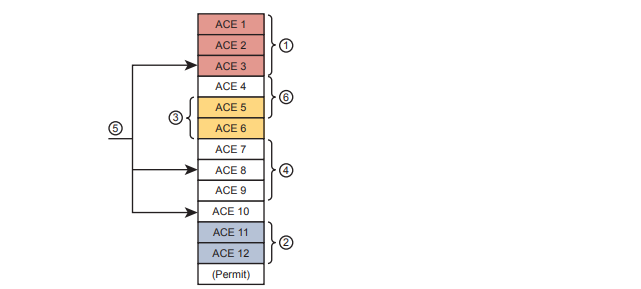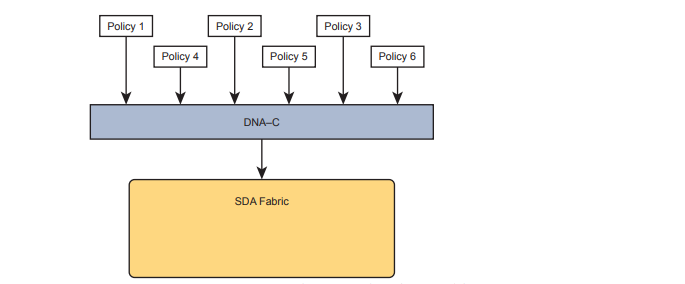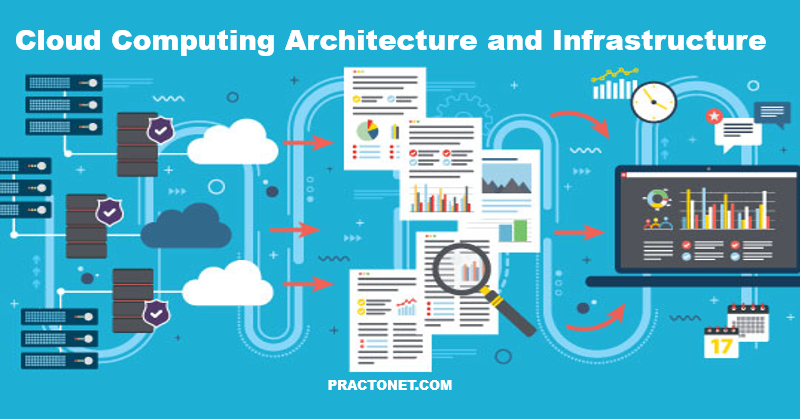In a broad sense, there are several fundamental differences between Cisco DNA Center and traditional network management platforms like Cisco PI. The largest difference: Cisco DNA Center supports SDA, whereas other management apps do not. Cisco PI still had some traditional management features not found in Cisco DNA Center. So think of PI as comprehensive to traditional device management, with Cisco DNA Center having many of those features, while focusing on future features like SDA support.
In terms of intent and strategy, Cisco focuses their development of Cisco DNA Center features toward simplifying the work done by enterprises, with resulting reduced costs and much faster deployment of changes. Cisco DNA Center features help make initial installation easier, simplify the work to implement features that traditionally have challenging configuration, and use tools to help you notice issues more quickly. Some of the features unique to Cisco DNA Center include:
- EasyQoS: Deploys QoS, one of the most complicated features to configure manually, with just a few simple choices from Cisco DNA Center
- Encrypted traffic analysis: Enables Cisco DNA to use algorithms to recognize security threats even in encrypted traffic
- Device 360 and Client 360: Gives a comprehensive (360-degree) view of the health of the device
- Network time travel: Shows past client performance in a timeline for comparison to current behavior
- Path trace: Discovers the actual path packets would take from source to destination based on current forwarding tables
Just to expound on one feature as an example, Cisco DNA Center’s Path Trace feature goes far beyond a traditional management application. A typical network management app might show a map of the network and let you click through to find the configuration on each device, including ACLs. The path trace feature goes much further. The DNA user (from the GUI or the API) specifies a source and destination host and optionally transport protocol and ports. Then the path trace feature shows a map of the path through the network and shows which ACLs are in the path, and whether they would permit or deny the packet.
All of Cisco Digital Network Architecture sets about to help customers reach some big goals: reduced costs, reduced risks, better security and compliance, faster deployment of services through automation and simplified processes, and the list goes on. Cisco DNA Center plays an important role, with all the functions available through its robust northbound API, and with its intent-based networking approach for SDA. Cisco DNA Center represents the future of network management for Cisco enterprises.
DNA Center as a Network Management Platform
This section uses Cisco Prime Infrastructure (PI) (www.cisco.com/go/primeinfrastructure) as an example of a traditional enterprise network management product. For many years, Cisco Prime Infrastructure has been Cisco’s primary network management product for the enterprise. It includes the following features:
- Single-pane-of-glass: Provides one GUI from which to launch all PI functions and features
- Discovery, inventory, and topology: Discovers network devices, builds an inventory, and arranges them in a topology map
- Entire enterprise: Provides support for traditional enterprise LAN, WAN, and data center management functions
- Methods and protocols: Uses SNMP, SSH, and Telnet, as well as CDP and LLDP, to discover and learn information about the devices in the network
- Lifecycle management: Supports different tasks to install a new device (day 0), configure it to be working in production (day 1), and perform ongoing monitoring and make changes (day n)
- Application visibility: Simplifies QoS configuration deployment to each device
- Converged wired and wireless: Enables you to manage both the wired and wireless LAN from the same management platform
- Software Image Management (SWIM): Manages software images on network devices and automates updates
- Plug-and-Play: Performs initial installation tasks for new network devices after you physically install the new device, connect a network cable, and power on
PI itself runs as an application on a server platform with GUI access via a web browser. The PI server can be purchased from Cisco as a software package to be installed and run on your servers, or as a physical appliance.
Cisco DNA
Cisco DNA Center exists as a software application that Cisco delivers pre-installed on a Cisco DNA Center appliance. The software follows the same general controller architecture concepts. Cisco DNA Center includes a robust northbound REST API along with a series of southbound APIs. For most of us, the northbound API matters most, because as the user of SDA networks, you interact with SDA using Cisco DNA Center’s northbound REST API or the GUI interface. Cisco DNA Center supports several southbound APIs so that the controller can communicate with the devices it manages. You can think of these as two categories:

- Protocols to support traditional networking devices/software versions: Telnet, SSH, SNMP
- Protocols to support more recent networking devices/software versions: NETCONF, RESTCONF
Cisco DNA Center needs the older protocols to be able to support the vast array of older Cisco devices and OS versions. Over time, Cisco has been adding support for NETCONF and RESTCONF to their more current hardware and software.
Cisco DNA Center and Scalable Groups
SDA creates many interesting new and powerful features beyond how traditional campus networks work. Cisco DNA Center not only enables an easier way to configure and operate those features, but it also completely changes the operational model.
Issues with Traditional IP-Based Security
Imagine the life of one traditional IP ACL in an enterprise. Some requirements occurred, and an engineer built the first version of an ACL with three Access Control Entries (ACEs)—that is , access-list commands—with a permit any at the end of the list. Months later, the engineer added two more lines to the ACL, so the ACL has the number of ACEs. The figure notes the lines added for requests one and two with the circled numbers in the figure.

Now think about that same ACL after four more requirements caused changes to the ACL, as noted. Some of the movement includes
- The ACEs for requirement two are now at the bottom of the ACL.
- Some ACEs, like ACE 5, apply to more than one of the implemented requirements.
- Some requirements, like requirement number five, required ACEs that overlap with multiple other requirements.

With the scenario in figure, no engineer could tell from looking at the ACL whether any lines in the ACL could be safely removed. You never know if an ACE was useful for one requirement or for many. If a requirement was removed, and you were even told which old project caused the original requirement so that you could look at your notes, you would not know if removing the ACEs would harm other requirements. Most of the time, ACL management suffers with these kinds of issues:
- ACEs cannot be removed from ACLs because of the risk of causing failures to the logic for some other past requirement.
- New changes become more and more challenging due to the length of the ACLs.
- Troubleshooting ACLs as a system—determining whether a packet would be delivered from end-to-end—becomes an even greater challenge.
SDA Security Based on User Groups
Imagine you could instead enforce security without even thinking about IP address ranges and ACLs. SDA does just that, with simple configuration, and the capability to add and remove the security policies at will. First, for the big ideas. Imagine that over time, using SDA, six different security requirements occurred. For each project, the engineer would define the policy with DNA Center, either with the GUI or with the API. Then, as needed, DNA Center would configure the devices in the fabric to enforce the security.

The SDA policy model solves the configuration and operational challenges with traditional ACLs. In fact, all those real issues with managing IP ACLs on each device are no longer issues with SDA’s group-based security model. For instance:
- The engineer can consider each new security requirement separately, without analysis of an existing (possibly lengthy) ACL.
- Each new requirement can be considered without searching for all the ACLs in the likely paths between endpoints and analyzing each and every ACL .
- DNA Center (and related software) keeps the policies separate, with space to keep notes about the reason for the policy.
- Each policy can be removed without fear of impacting the logic of the other policies.
SDA and Cisco DNA achieve this particular feature by tying security to groups of users, called scalable groups, with each group assigned a scalable group tag (SGT). Then the engineer configures a grid that identifies which SGTs can send packets to which other SGTs. For instance, the grid might include SGTs for an employee group, the Internet (for the Enterprise’s WAN routers that lead to the Internet), partner employees, and guests, with a grid like the one shown in Table.
| Source\Destination | Employee | Internet | Partner | Guest |
|---|---|---|---|---|
| Employee | N/A | Permit | Permit | Deny |
| Internet | Permit | N/A | Permit | Permit |
| Partnet | Permit | Permit | N/A | Deny |
| Guest | Demy | Permit | Deny | N/A |
To link this security feature back to packet forwarding, consider when a new endpoint tries to send its first packet to a new destination. The ingress SDA node starts a process by sending messages to DNA Center. DNA Center then works with security tools in the network, like Cisco’s Identity Services Engine (ISE), to identify the users and then match them to their respective SGTs. DNA Center then checks the logic similar to Table. . If DNA Center sees a permit action between the source/destination pair of SGTs, DNA Center directs the edge nodes to create the VXLAN tunnel. If the security policies state that the two SGTs should not be allowed to communicate, DNA Center does not direct the fabric to create the tunnel, and the packets do not flow.

The operational model with scalable groups greatly simplifies security configuration and ongoing maintenance of the security policy, while focusing on the real goal: controlling access based on user. From a controller perspective, the fact that Cisco DNA Center acts as much more than a management platform, and instead as a controller of the activities in the network, makes for a much more powerful set of features and capabilities.





